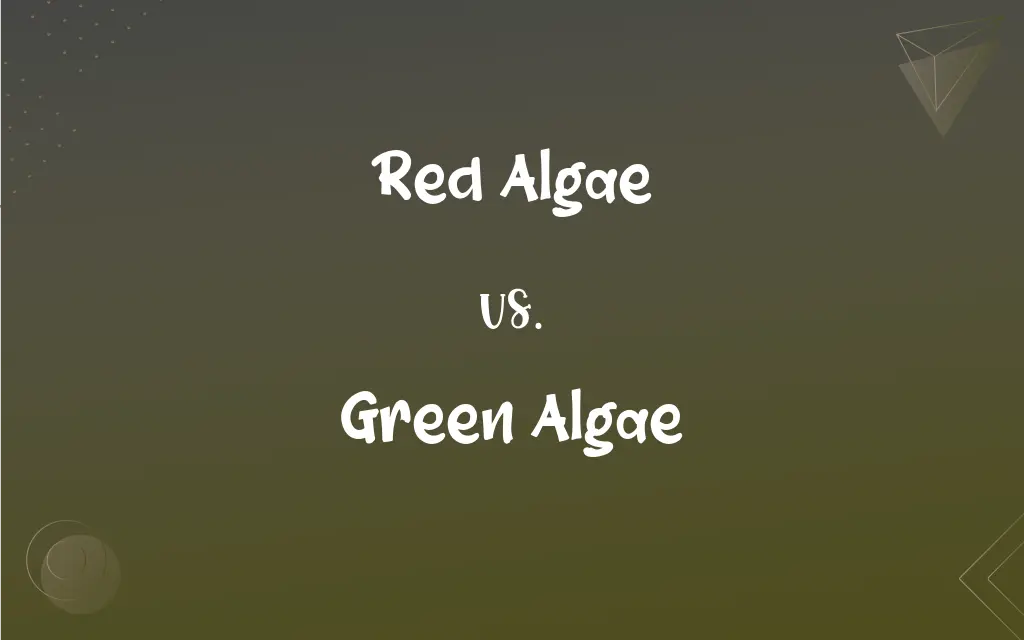Red Algae vs. Green Algae: What's the Difference?
Edited by Aimie Carlson || By Harlon Moss || Updated on October 13, 2023
Red algae typically thrive in deeper waters and have phycoerythrin, which gives them their color; green algae are versatile, inhabiting various environments, and contain chlorophyll that renders them green.

Key Differences
Red algae, belonging to the phylum Rhodophyta, are recognized for their distinctive, often vibrant red coloration, attributed to the presence of a pigment known as phycoerythrin. This pigment allows them to absorb blue light, enabling them to inhabit and photosynthesize in deeper, dimmer aquatic environments. On the other hand, green algae, falling under Chlorophyta, exhibit a bright green hue due to their chlorophyll content, which is particularly adept at absorbing sunlight and is also found in terrestrial plants.
Interestingly, the depth at which red and green algae are found in aquatic environments often differs due to their pigmentation. Red algae, capable of absorbing the blue light available in deeper water, are commonly found in such lower light conditions. In contrast, green algae, while also present in aquatic locales, are typically found in shallower, well-lit waters due to their chlorophyll’s proficiency in capturing sunlight.
The versatility of green algae is noteworthy, as they not only inhabit various water bodies but are also found in damp terrestrial environments, like on tree trunks or rocks. Red algae predominantly reside in oceanic environments, utilizing their specialized pigment to inhabit niches where other algae might struggle to perform photosynthesis, which demonstrates a divergence in their ecological roles and habitats between the two.
Reproduction strategies of red algae and green algae also exhibit distinctions. Red algae tend to have complex life cycles and can reproduce both sexually and asexually, often involving alternate generations. Green algae, while also utilizing both sexual and asexual reproduction, often exhibit simpler life cycles and have a diverse array of reproductive strategies that can vary significantly across different species.
In terms of utility and applications, red algae and green algae again showcase variance. Red algae are often harvested for agar and carrageenan, substances used in culinary and scientific applications for their gelling properties. Meanwhile, certain species of green algae, thanks to their high nutrient content and rapid growth, are explored for uses in biofuel production, waste treatment, and as a food source, signifying the divergent applicative potentials of red and green algae.
ADVERTISEMENT
Comparison Chart
Pigment
Phycoerythrin
Chlorophyll
Typical Habitats
Predominantly aquatic, especially in deeper waters
Aquatic and damp terrestrial environments
Light Absorption
Absorbs blue light, suited for deeper waters
Absorbs sunlight, usually found in well-lit areas
Reproductive Strategies
Complex life cycles, both sexual and asexual
Diverse, simpler life cycles, sexual and asexual
Applications and Uses
Agar, carrageenan production
Biofuel, waste treatment, and food
ADVERTISEMENT
Red Algae and Green Algae Definitions
Red Algae
Red algae are primarily marine algae with a characteristic red pigment.
The vibrant red algae added a burst of color to the ocean floor.
Green Algae
Green algae are explored for applications in biofuel production due to their rapid growth and nutrient content.
Scientists are developing techniques to efficiently convert green algae into biofuel.
Red Algae
Red algae can have complex, alternating generations in their life cycles.
The life cycle of red algae fascinates biologists due to its multifaceted nature.
Green Algae
Green algae can inhabit various environments, including water bodies and damp terrestrial locations.
Green algae clung to the damp, shaded rock, showcasing its environmental versatility.
Red Algae
Red algae often inhabit ocean environments, contributing to marine ecosystems.
The thriving red algae played a vital role in the local marine ecosystem’s balance.
Green Algae
Green algae are photosynthetic organisms with a vibrant green color due to chlorophyll.
The pond was blanketed in a layer of vivid green algae.
Red Algae
Red algae are utilized for extracting gelling agents like agar and carrageenan.
Agar, derived from red algae, is widely used in microbiological research.
Green Algae
Green algae serve as a crucial food source for various aquatic organisms and even humans in some cultures.
In certain regions, green algae are harvested and incorporated into local cuisine.
Red Algae
Red algae possess the pigment phycoerythrin, enabling deep-water living.
The red algae utilize phycoerythrin to absorb blue light in the ocean depths.
Green Algae
Green algae engage in both sexual and asexual reproduction with sometimes simple, varied life cycles.
Researchers studied the green algae’s reproductive habits in different environmental contexts.
FAQs
What color are red algae typically?
Red algae usually exhibit a red to purplish color due to phycoerythrin.
Where are green algae commonly found?
Green algae inhabit diverse environments, from water bodies to damp terrestrial areas.
What is a significant use of red algae in laboratories?
Red algae are used to produce agar, which is utilized as a growth medium in laboratories.
How do green algae contribute to waste treatment?
Green algae can absorb and neutralize pollutants, thus being explored for use in waste treatment.
Do red algae only live in marine environments?
Predominantly yes, red algae are largely marine but can occasionally be found in freshwater.
Are green algae always green?
Predominantly yes, due to chlorophyll, but color can vary slightly depending on the environment and species.
Do green algae play a role in ecological systems?
Absolutely, green algae are fundamental in various ecosystems, providing food and oxygen.
Is there a symbiotic relationship involving red algae?
Yes, red algae form symbiotic relationships with organisms like corals, providing them with nutrients.
Why are green algae considered for biofuel production?
Their rapid growth and high nutrient content make green algae a candidate for biofuel production.
What substance in red algae is used in food preparation?
Carrageenan, derived from red algae, is used as a thickener and stabilizer in foods.
What allows red algae to live in deeper water?
The pigment phycoerythrin allows red algae to absorb blue light in deeper water.
Are red algae edible?
Yes, certain species of red algae are edible and used in various cuisines.
What kind of light do red algae absorb?
Red algae absorb blue light, enabling them to live in deeper water.
Can green algae live on land?
Yes, green algae can inhabit damp terrestrial locations, like rocks and trees.
How do green algae reproduce?
Green algae reproduce through both sexual and asexual means, with varied life cycles across species.
Are red algae found in freshwater environments?
Rarely, red algae predominantly inhabit marine environments but a few species exist in freshwater.
Can green algae be harmful to aquatic environments?
In excessive amounts, green algae blooms can be harmful, causing issues like oxygen depletion in water bodies.
How do red algae reproduce?
Red algae reproduce through a combination of sexual and asexual methods, often with complex life cycles.
What organisms commonly feed on green algae?
Various organisms, from small aquatic animals like zooplankton to larger ones like turtles, consume green algae.
Are green algae plants?
While they photosynthesize, green algae are not classified as plants and belong to the Chlorophyta division.
About Author
Written by
Harlon MossHarlon is a seasoned quality moderator and accomplished content writer for Difference Wiki. An alumnus of the prestigious University of California, he earned his degree in Computer Science. Leveraging his academic background, Harlon brings a meticulous and informed perspective to his work, ensuring content accuracy and excellence.
Edited by
Aimie CarlsonAimie Carlson, holding a master's degree in English literature, is a fervent English language enthusiast. She lends her writing talents to Difference Wiki, a prominent website that specializes in comparisons, offering readers insightful analyses that both captivate and inform.
































































